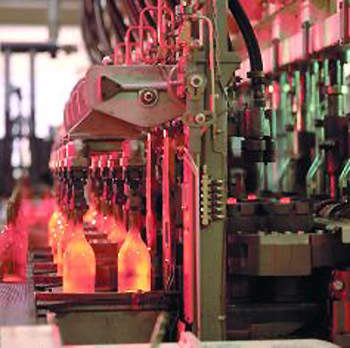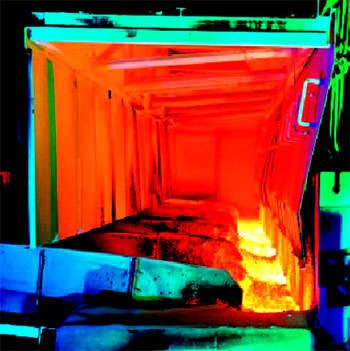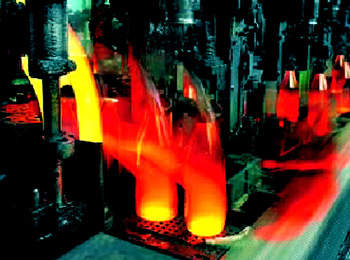Irish glass manufacturer Quinn Glass has constructed a production and distribution facility on a 205-acre site at Ince in North West England. The site provides a comprehensive glass packaging, filling and distribution service for the drinks
industry.
One of only a handful of plants worldwide where bottles can be manufactured and filled on a single site, it features one of the largest automated warehouses in Europe, capable of handling 282,000 pallets of filled and unfilled glass containers.
Construction and controversy
Construction began in September 2003 and the plant was expected to be in production by the end of 2005.
The opening was delayed because of objections from rival glass makers in Yorkshire (Rockware, now known as Ardagh Glass UK) and a retrospective new planning application which was refused in January 2007 by the Secretary of State Ruth Kelly. The plant is now working and has created over 700 jobs.
The planning application was finally approved in September 2009 by the Secretary of State for the Department for Communities and Local Government.
In February 2007 Quinn’s Barnsley rival Rockware closed one of its furnaces in order to consolidate and restructure its business; it blamed Quinn for overcapacity in the glass bottle market, which led directly to its closure. The planning wrangling led to a public enquiry but Quinn fought this off.
Objections at the enquiry included the overcapacity of the road leading to the plant. Quinn responded by agreeing to share a nearby rail link with a local fertiliser firm and even agreed that their plant could use some of the by-products from the fertiliser plant in manufacturing glass.
A fresh planning application was submitted in February 2008 addressing the concerns that Ruth Kelly raised in the previous refusal.
Quinn Glass planning permission
Atkins provided the planning consultancy services for the 65ha of the former Ince Power Station site at the edge of the River Mersey Estuary in Cheshire, where the new facility is constructed. The Northwest Development Agency gave grant aid of £4.9m and the Department of Trade and Industry provided regional incentives.
The council initially granted planning permission in October 2003. Quinn Glass then submitted a subsequent application to increase the size of its proposed plant by 25%, build more production lines and change the furnace. Although this meant the company was forced by the High Court to make a fresh application, it used the previous planning permission granted for the smaller plant to continue building work in the interim.
Quinn received planning permission for an eight machine line / three filling line factory in October 2003. The bottling and filling plant is in full production and has a capacity of 1.2 billion glass containers a year. The UK glass market currently has a demand of about 7 billion glass bottles a year.
Quinn had originally received planning permission from the city council to operate two oxyfuel furnaces and eight glass making lines. The company later changed its plans to put in place two larger gas fuelled furnaces and 13 machine lines, a 60%
increase in size.
Changes in detail
The footprint of the main building increased from 91,870m² to 109,100m². The total gross floor area (all buildings) increased from 112,736m² to 145,225m².
The furnaces are two 600t (melt capacity per day) gas/air fired furnaces compared to two 500t oxy/fuel fired furnaces (oxy/fuel furnaces are considered to be cleaner technology). They are regenerative furnaces and are controlled at 1,300°C.
The exhaust stack remained the same height of 76m. A 38m stack at the filling hall was introduced for the release of emissions from the boiler used in the filling hall.
The number of production lines was increased from eight to 13, each of 12 sections. The capacity of the new plant was given as 370,000t/yr of glass compared to the approved 310,000t/yr of glass.
The capacity of the automated warehouse was been increased from 200,000 pallet storage locations to 282,000, a 40.5% increase.
Glass manufacturing control systems
The decision was eventually taken to award the control systems contract to Siemens, because of their glass manufacturing control systems expertise and available support.
The selected system was the Siemens Moore Process Automation (SMPA) Simatic PCS7 process control system, which was configured and commissioned, in partnership with Worksop-based systems integrator, Process Control and Automation Ltd.
The system includes five operator stations, almost 3,500 I/O points, as well as furnace, forehearth / distributor, lehr and utilities control. Local operation of the lehr equipment is also available via Siemens OP25 operator panels.
A Profibus fieldbus network provides communication at plant level, while data from the operator stations is carried across an Ethernet TCP/IP network which will eventually link to Quinn’s own MIS system.
Simatic PCS7 is used to control and operate what is termed the ‘hot end’ of the manufacturing process plus the site utilities. This covers everything from the recipe control, through introduction of raw materials into the furnaces and on to the forehearths and lehrs.
Forehearths are used to provide a continuous feed of molten glass into the bottle-forming machinery. At Quinn Glass there are four forehearths per furnace, giving a total of eight bottling lines. After the glass has been formed, the bottles, which at this point are still red hot, pass into a lehr. It is here that the glass is annealed before the bottles move onto the inspection and packaging lines.
Accurate furnace control is critical. The temperature is usually maintained between 1,580°C and 1,590°C when all eight lines are producing.
The furnaces utilise two chambers. Every 20 minutes the flow of heat is switched from one chamber to the other. This is operated using the PCS7 system to achieve more control and precision than would normally be possible.
Most furnaces have individual chimneys. However, at Quinn Glass the plant uses a single stack fed from both furnaces.
Using this configuration, changes in pressure within the stack or furnace could potentially cause problems within one or both furnaces, affecting temperature and air flow into the furnaces.
PCA overcame this using the Simatic PCS7 system, which provides more flexible control than conventional Programmable Controller (PLC) or Distributed Control System (DCS) solutions.
Quinn Glass SCR plant
Quinn glass installed and commissioned an SCR (Selective Catalytic Reduction) unit in 2005 while in full operation and without any interruption to the output of the two furnaces at the facility.
The SCR unit was required to reduce the NOx (nitrogen oxides) emissions from the plant to below a government specified level. The readings recorded for NOx and ammonia have met the levels laid down by the UK government. The SCR unit uses aqueous ammonia (the reacting agent) and titanium oxide (the catalyst).
The ammonia is injected into the SCR unit along with the waste flue gas from the furnaces. The ammonia reduces the amount of NOx in the flue gas in the presence of the catalyst to a level that is currently unachievable by any other comparable glass plant in the UK.
State-of-the-art warehousing
Stocklin constructed the automated high-bay warehouse for Quinn Glass. Stocklin were the general materials handling equipment contractor, and provided the entire materials handling and logistics systems including conveyors, stacker cranes, material flow controls and warehouse management system.
The warehouse system has a storage volume of 282,000 pallet locations and covers an area of 52,000m². There are 24 state-of-the-art Stocklin MASTer stacker cranes, 33m in height, which store the palletised glass bottles quickly and securely in 290m-long aisles. A pallet conveying system, 1.4km in length, connects the automated warehouse with production, filling, QA and despatch operations.
Quinn Glass bottling plant
Quinn Glass installed a bottling facility at its Cheshire plant in 2005 in an attempt to provide an integrated packaging facility for spirits, beer and cider, wine and soft drinks.
The plant has five lines capable of bottling a total of 400 bottles of wine, or 1,000 bottles of beer a minute. Having manufacturing and bottling on the same site can reduce costs and keep prices competitive.
The equipment was supplied and installed by Krones UK. The first bottling was in October 2005. Intake was purpose designed and built by GEA Tuchenhagen.
The plant has a completely hygienic process throughout, all the pipe works and valves are stainless steel; the only flexi hoses on the site are between tanker and intake bay. The intake and tank farm are operated by a fully integrated control system which is linked to the quality system to ensure QC release before intake.
The fully operational lines can fill bottles at a speed between 60,000bph for 33cl bottles and 24,000bph for 75cl bottles. The facility also provides sticking of self adhesive and wet glue labels on the bottles.
The plant also has bottle pasteurisation facilities.
Storage is in stainless steel vessels with the 24 tanks for wine and spirits storing a capacity of 720,000l and 28 storage tanks for beer, FAB’s (Flavoured Alcoholic Beverages) and soft drinks with the capacity to store in excess of a million litres. These vessels are insulated to maintain temperature with CO2 and N2 top gases.
By offering bottling services, there is the potential for glass makers to win more business as an overflow plant in times of high demand, and it is as a contract packing operation that the greatest benefits from bottling lines are likely to be had.
New designs
In February 2008 a new bottle was launched by PepsiCo for its new product Pepsi RAW. The new bottle was designed by Ziggurat Brands of Italy. The bottle is being produced by Quinn Glass at the Cheshire plant in the ‘traditional’ Pepsi shape (redesign by Ziggurat, produced in flint glass). The copper coloured closure (crown cork made of tin plate) has been produced by Pelliconi of Italy. The branding on the bottle shows the RAW brand name in vertical letters along the bottle neck with a white Pepsi logo printed below. Quinn Glass is able to do all of the production work and even filling at their fully integrated plant.
In September 2009, Quinn Glass launched the world’s first 300g wine bottle for use in Tesco supermarkets. The new bottle weighs 56g lesser than the previous light weight bottles. The design was the result of the combined efforts of Quinn’s, Tesco , Kingland Wine and Spirits and the Waste & Resources Action Programme which encourages light weight bottles.
A new glass colour named ‘Not’ has also been introduced . It is currently being used in the packaging of entry-level wine bottles. ‘Not’ is a combination of clear and green glass. ‘Not’ was developed with an intention to save waste and improve the production efficiency while changing the colour of the recovered glass in the furnace.






